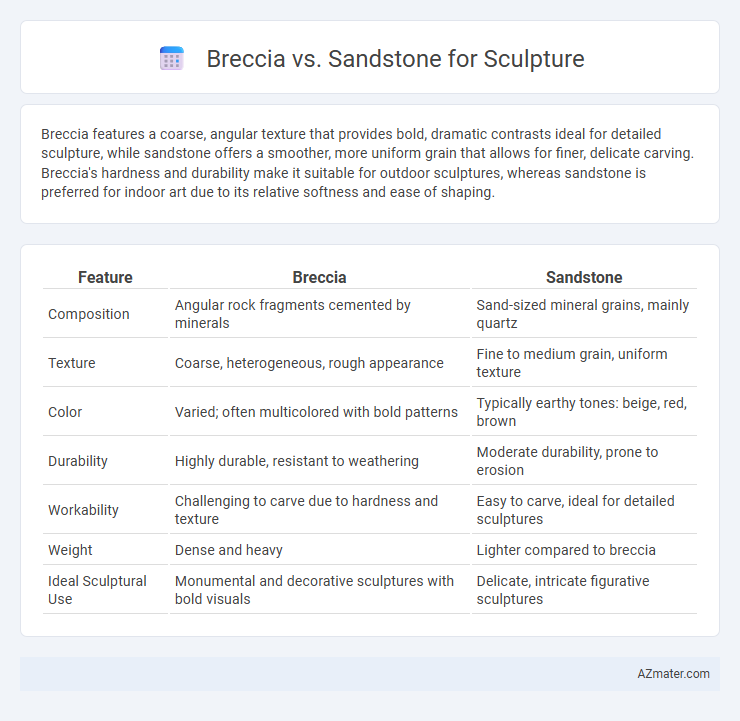Breccia features a coarse, angular texture that provides bold, dramatic contrasts ideal for detailed sculpture, while sandstone offers a smoother, more uniform grain that allows for finer, delicate carving. Breccia's hardness and durability make it suitable for outdoor sculptures, whereas sandstone is preferred for indoor art due to its relative softness and ease of shaping.
Table of Comparison
| Feature | Breccia | Sandstone |
|---|---|---|
| Composition | Angular rock fragments cemented by minerals | Sand-sized mineral grains, mainly quartz |
| Texture | Coarse, heterogeneous, rough appearance | Fine to medium grain, uniform texture |
| Color | Varied; often multicolored with bold patterns | Typically earthy tones: beige, red, brown |
| Durability | Highly durable, resistant to weathering | Moderate durability, prone to erosion |
| Workability | Challenging to carve due to hardness and texture | Easy to carve, ideal for detailed sculptures |
| Weight | Dense and heavy | Lighter compared to breccia |
| Ideal Sculptural Use | Monumental and decorative sculptures with bold visuals | Delicate, intricate figurative sculptures |
Introduction to Breccia and Sandstone in Sculpture
Breccia is a clastic sedimentary rock composed of angular fragments cemented together, prized in sculpture for its striking, irregular patterns and varied colors that create dynamic visual effects. Sandstone, formed from compacted sand grains, offers a more uniform texture and durability, making it suitable for detailed carving and outdoor sculptures. Both stones provide unique aesthetic qualities and workability, influencing artists' material choices based on the desired finish and structural requirements.
Geological Origins of Breccia and Sandstone
Breccia forms from the cementation of angular rock fragments produced by mechanical weathering and tectonic activity, often found near fault zones or volcanic regions, giving it a unique texture for sculpture. Sandstone originates from compacted sand grains deposited in riverbeds, deserts, or marine environments, characterized by its granular texture and range of mineral compositions like quartz and feldspar. The geological origin of breccia imparts a more rugged, heterogeneous appearance, while sandstone offers smoother, uniform layers ideal for detailed sculpting.
Physical Properties: Breccia vs Sandstone
Breccia features angular, coarse fragments cemented tightly, providing a rugged texture and higher compressive strength ideal for detailed, durable sculptures. Sandstone consists of finer, more uniform grains, offering ease of carving but often less structural strength and a more porous surface that may require sealing. Both stones vary in hardness and weather resistance, with Breccia generally outperforming Sandstone in longevity and impact resistance for outdoor sculptural applications.
Workability for Sculptors
Breccia offers superior workability for sculptors due to its coarse, angular clasts bound in a finer matrix, allowing for detailed carving and a striking textural contrast. Sandstone, composed of compacted sand grains, provides a softer, more uniform surface but may lack the durability and intricate detail that breccia allows when sculpting. The choice between breccia and sandstone hinges on the desired finish and level of precision, with breccia favored for its hardness and aesthetic complexity.
Aesthetic Qualities and Color Variations
Breccia offers striking aesthetic qualities with its angular fragments and dynamic patterns, making it ideal for sculptures that emphasize texture and bold visual contrasts. Sandstone provides a softer, more uniform appearance with warm earthy tones and subtle color variations, lending itself to sculptures that require smooth finishes and natural elegance. Both materials present unique color palettes, with Breccia showcasing a mix of vibrant hues shaped by mineral inclusions, while Sandstone's colors range from creamy whites to rich reds and browns.
Durability and Weather Resistance
Breccia offers excellent durability and superior weather resistance compared to sandstone, making it ideal for outdoor sculptures exposed to harsh elements. The angular clasts in breccia create a dense, compact structure that resists erosion and mechanical wear better than the softer, more porous sandstone. Sandstone, while easier to carve, tends to absorb moisture and degrade over time, especially in freeze-thaw climates, limiting its longevity in exterior sculptural applications.
Popular Sculptural Applications
Breccia, with its angular fragments and varied colors, is prized for bold, textured sculptures that emphasize contrast and rugged aesthetics, often featured in contemporary public art and architectural embellishments. Sandstone offers a softer, more uniform grain suited for detailed carvings and classical statues, commonly used in historical monuments and garden sculptures due to its workability and weather resistance. Both stones are favored for durability, but breccia's striking patterns create statement pieces, while sandstone's smooth consistency allows for intricate, refined designs.
Cost and Availability Comparison
Breccia and sandstone vary significantly in cost and availability for sculpture projects, with Breccia typically commanding a higher price due to its unique composition of angular fragments cemented together, often sourced from limited quarry locations. Sandstone is more abundant and widely accessible, making it a cost-effective choice for sculptors, especially in regions with extensive sedimentary deposits. The durability and aesthetic appeal of Breccia may justify its premium cost, whereas sandstone offers versatility and ease of procurement for larger or budget-conscious sculptural works.
Preservation and Maintenance
Breccia offers superior preservation qualities for sculpture due to its hardness and resistance to weathering, reducing the risk of erosion and surface damage over time. Sandstone, while easier to carve, requires more frequent maintenance because its porosity makes it vulnerable to moisture absorption and environmental pollutants. Regular sealing and gentle cleaning are essential to maintain sandstone sculptures, whereas breccia sculptures demand less intensive upkeep, ensuring long-term durability.
Choosing the Right Stone for Your Sculpture
Breccia offers a striking visual impact with its angular fragments and diverse colors, making it ideal for sculptures that require bold, textured surfaces. Sandstone provides a softer, more uniform grain that is easier to carve, suitable for intricate details and smooth finishes in sculptural work. When choosing between breccia and sandstone, consider the desired aesthetic, durability, and carving complexity to ensure the stone aligns with the artistic vision and longevity of the sculpture.

Infographic: Breccia vs Sandstone for Sculpture
 azmater.com
azmater.com